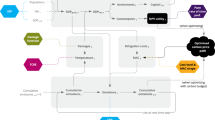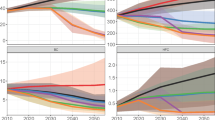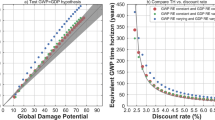Abstract
With advancing climate change there is a growing need to include short-lived climate forcings in cost-efficient mitigation strategies to achieve international climate policy targets. Tools are required to compare the climate impact of perturbations with distinctively different atmospheric lifetimes and atmospheric properties. We present a generic approach for relating the climate effect of short-lived climate forcers (SLCF) to that of CO2 emissions. We distinguish between three alternative types of metric-based factors that can be used to derive CO2 equivalences for SLCF: based on forcing, activity and fossil fuel consumption. We derive numerical values for a wide range of parameter assumptions and apply the resulting generalised approach to the practical example of aviation-induced cloudiness. The evaluation of CO2 equivalences for SLCF tends to be more sensitive to SLCF specific physical uncertainties and the normative choice of a discount rate than to the choice of a physical or economic metric approach. The ability of physical metrics to approximate economic-based metrics alters with changing atmospheric concentration levels and trends. Under reference conditions, physical CO2 equivalences for SLCF provide sufficient proxies for economic ones. The latter, however, allow detailed insight into structural uncertainties. They provide CO2 equivalences for SLCF in short term strategies in the face of failing climate policies, and a temporal evolution of CO2 equivalences over time that is noticeably better in line with cost-efficient climate stabilisation.



Similar content being viewed by others
References
Azar C, Johansson DJA (2011) Valuing the non-CO2 climate impacts of aviation. Clim Chang. doi:10.1007/s10584-011-0168-8
Berntsen T, Fuglestvedt J, Myhre G, Stordal F, Berglen TF (2006) Abatement of greenhouse gases: does location matter? Clim Chang. doi:10.1007/s10584-006-0433-4
Boer GJ, Yu B (2003) Climate sensitivity and response. Clim Dyn. doi:10.1007/s00382-002-0283-3
Bond TC, Zarzycki C, Flanner MG, Koch DM (2011) Quantifying immediate radiative forcing by black carbon and organic matter with the Specific Forcing Pulse. Atmos Chem Phys. doi:10.5194/acp-11-1505-2011
Boucher O (2012) Comparison of physically- and economically-based CO2-equivalences for methane. Earth Syst Dyn. doi:10.5194/esd-3-49-2012
Boucher O, Reddy MS (2008) Climate trade-off between black carbon and carbon dioxide emissions. Energy Policy. doi:10.1016/j.enpol.2007.08.039
Burkhardt U, Kärcher B (2011) Global radiative forcing from cirrus. Nat Clim Chang. doi:10.1038/nclimate1068
Deuber O, Luderer G, Edenhofer O (2013a) Physico-economic evaluation of climate metrics: a conceptual framework. Environ Sci Pol. doi:10.1016/j.envsci.2013.01.018
Deuber O, Matthes S, Sausen R, Ponater M, Lim L (2013b) A physical metric-based framework for evaluating the climate trade-off between CO2 and contrails – the case of lowering aircraft flight trajectories. Environ Sci Pol. doi:10.1016/j.envsci.2012.10.004
Dorbian CS, Wolfe PJ, Waitz IA (2011) Estimating the climate and air quality benefits of aviation fuel and emission reductions. Atmos Environ. doi:10.1016/j.atmosenv.2011.02.025
Eckhaus RS (1992) Comparing the effects of greenhouse gas emissions on global warming. Energy J 13:25–35
Forster P, Shine K, Stuber N (2006) It is premature to include non-CO2 effects of aviation in emission trading schemes. Atmos Environ. doi:10.1016/j.atmosenv.2005.11.005
Forster P, Ramaswamy V et al (2007) Changes in atmospheric constituents and in radiative forcing. In: Solomon S, Qin D, Manning M, Chen Z, Marquis M, Averyt KB, Tignor M, Miller HL (eds) Climate change 2007: the physical science basis. Contribution of Working Group I to the Fourth Assessment Report of the Intergovernmental Panel on Climate Change. Cambridge University Press, Cambridge
Frömming C, Ponater M, Dahlmann K, Grewe V, Lee DS, Sausen R (2012) Aviation-induced radiative forcing and surface temperature change in dependency of the emission altitude. J Geophys Res. doi:10.1029/2012JD018204
Fuglestvedt JS, Shine KP, Berntsen T, Cook J, Lee DS, Stenke A, Skeie RB, Velders GJM, Waitz IA (2010) Transport impacts on atmosphere and climate: metrics. Atmos Environ. doi:10.1016/j.atmosenv.2009.04.044
Gierens K, Sausen R, Schumann U (1999) A diagnostic study of the global distribution of SLCFs part II: future air traffic scenarios. Theor Appl Climatol. doi:10.1007/s007040050087
Gillett NP, Matthews HD (2010) Accounting for carbon cycle feedbacks in a comparison of the global warming effects of greenhouse gases. Environ Res Lett. doi:10.1088/1748-9326/5/3/034011
Hammitt JKH, Jain AK, Adams JL, Wuebbles DJ (1996) A welfare-based index for assessing environmental effects of greenhouse-gas emissions. Nature. doi:10.1038/381301a0
Hansen J, Sato M, Ruedy L, Nazarenko L et al (2005) Efficacy of climate forcing. J Geophys Res. doi:10.1029/2005JD005776
Hasselmann K, Hasselmann S, Giering R, Ocana V, von Storch H (1997) Sensitivity study of optimal CO2 emission paths using a Simplified Structural Integrated Assessment Modal (SIAM). Clim Chang. doi:10.1023/A:1005339625015
IEA (International Energy Agency) (2009) Oil information 2009. ISBN 978-92-64-06099-9
IPCC (Intergovernmental Panel on Climate Change) (1990) In: Houghton JT, Jenkins GJ, Ephraums JJ (eds) Climate change: the Inter-governmental Panel on Climate Change Scientific Assessment. Cambridge University Press, Cambridge, 364 pp
Jackson SC (2009) Parallel pursuit of near-term and long-term climate mitigation. Science. doi:10.1126/science.1177042
Johansson DJA (2012) Economics and physical-based metrics for comparing greenhouse gases. Clim Chang. doi:10.1007/s10584-011-0072-2
Joshi M, Shine K, Ponater M, Stuber N, Sausen R, Li L (2003) A comparison of climate response to different radiative forcings in three general circulation models: towards an improved metric of climate change. Clim Dyn. doi:10.1007/s00382-003-0305-9
Lee DS, Fahey DW, Forster PM, Newton PJ, Wit RCN, Lim LL, Owen B, Sausen R (2009) Aviation and global climate change in the 21st century. Atmos Environ. doi:10.1016/j.atmosenv.2009.04.024
Lee DS, Pitari G, Grewe V et al (2010) Transport impacts on atmosphere and climate: aviation. Atmos Environ. doi:10.1016/j.atmosenv.2009.06.005
Lim L, Lee DS (2006) Quantifying the effects of aviation on radiative forcing and temperature with a climate response model. Proceeding of the TAC Conference. June 26 to 29. Oxford, UK
Lund MT, Berntsen T, Fuglestvedt JS, Ponater M, Shine KP (2012) How much information is lost by using global-mean climate metrics? An example using the transport sector. Clim Chang. doi:10.1007/s10584-011-0391-3
Marais K, Lakachko SP, Jun M, Mahashabde A, Waitz IA (2008) Assessing the impact of aviation on climate. Meteorol Z. doi:10.1127/0941-2948/2008/0274
Masui T, Matsumoto K, Hijioka Y, Kinoshita TN et al (2011) An emission pathway for stabilization at 6 Wm-2 radiative forcing. Clim Chang. doi:10.1007/s10584-011-0150-5
Nordhaus WD, Boyer J (2000) Warming the world: economic models of global warming. MIT Press, Cambridge
Penner JE, Prather MJ, Isaksen ISA, Fuglestvedt JS, Zbigniew K, Stevenson DS (2010) Short-lived uncertainty? Nat Geosci. doi:10.1038/ngeo932
Plattner GK, Stocker T, Midgley P, Tignor M (2009) Expert Meeting on the Science of Alternative Metrics, Oslo, Norway, 18-20 March 2009. Meeting Report
Ponater M, Marquart S, Sausen R, Schumann U (2005) On contrail climate sensitivity. Geophys Res Lett. doi:10.1029/2005GL022580
Rap A, Forster PM, Haywood JM, Jones A, Boucher O (2010) Estimating the climate impact of linear contrails using the UK Met Office climate model. Geophys Res Lett. doi:10.1029/2010GL045161
Roeckner E, Bengtsson L, Feichter J, Leliveld J, Rohde H (1999) Transient climate change simulation with a coupled atmosphere-ocean GCM including the tropospheric sulphur cycle. J Clim. doi:10.1175/1520-0442(1999)012<3004:TCCSWA>2.0.CO;2
Rypdal K, Berntsen T, Fuglestvedt J, Aunan K, Torvanger A, Stordal F, Pacyna J, Nygaard L (2005) Tropospheric ozone and aerosols in climate agreements: scientific and political challenges. Environ Sci Pol. doi:10.1016/j.envsci.2004.09.003
Sausen R, Schumann U (2000) Estimates of the climate response to aircraft CO2 and NOx emissions scenarios. Clim Chang. doi:10.1023/A:1005579306109
Schumann U (2005) Formation, properties and climatic effects of contrails. C R Phys. doi:10.1016/j.crhy.2005.05.002
Shine KP (2009) The global warming potential – the need for an interdisciplinary retrial. An editorial comment. Clim Chang. doi:10.1007/s10584-009-9647-6
Shine KP, Fuglestvedt JS, Hailermariam K, Stuber N (2005) Alternatives to the global warming potential for comparing climate impacts of emissions of greenhouse gases. Clim Chang. doi:10.1007/s10584-005-1146-9
Shine KP, Berntsen TK, Fuglestvedt JS, Skeie RB, Stuber N (2007) Comparing the climate effect of emissions of short- and long-lived climate agents. Philos Trans R Soc A. doi:10.1098/rsta.2007.2050
Smith SM, Lowe JA, Bowerman NHA, Gohar LK, Huntingford C, Allan MR (2012) Equivalence of greenhouse-gas emissions for peak temperature limits. Nat Clim Chang. doi:10.1038/nclimate1496
Stern N (2007) The economics of climate change. The Stern review. Cambridge University Press, New York
Tanaka K, Peters GP, Fuglestvedt JS (2010) Multicomponent climate policy: why do emission metrics matter? Carbon Manag 1:191–197
Van Vuuren DP, Stehfest E, den Elzen MGJ et al (2011) RCP2.6: exploring the possibility to keep global mean temperature increase below 2°C. Clim Chang. doi:10.1007/s10584-011-0152-3
Acknowledgments
This paper is part of the PhD thesis of Odette Deuber, who was funded by the Heinrich Böll Stiftung. We are grateful to Ling Lim and David S Lee (Manchester Metropolitan University) for providing the model LinClim. We thank the anonymous reviewers for their constructive comments.
Author information
Authors and Affiliations
Corresponding author
Electronic supplementary material
Below is the link to the electronic supplementary material.
ESM 1
(DOC 77 kb)
Rights and permissions
About this article
Cite this article
Deuber, O., Luderer, G. & Sausen, R. CO2 equivalences for short-lived climate forcers. Climatic Change 122, 651–664 (2014). https://doi.org/10.1007/s10584-013-1014-y
Received:
Accepted:
Published:
Issue Date:
DOI: https://doi.org/10.1007/s10584-013-1014-y




